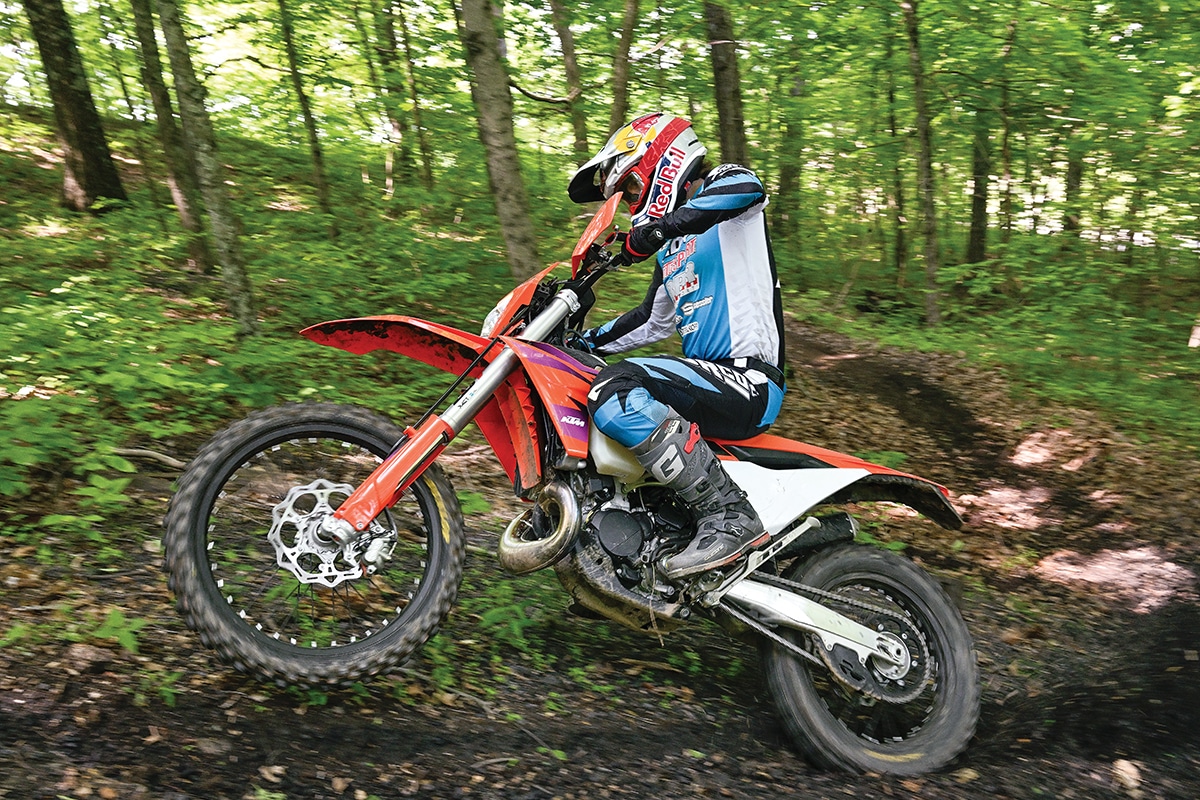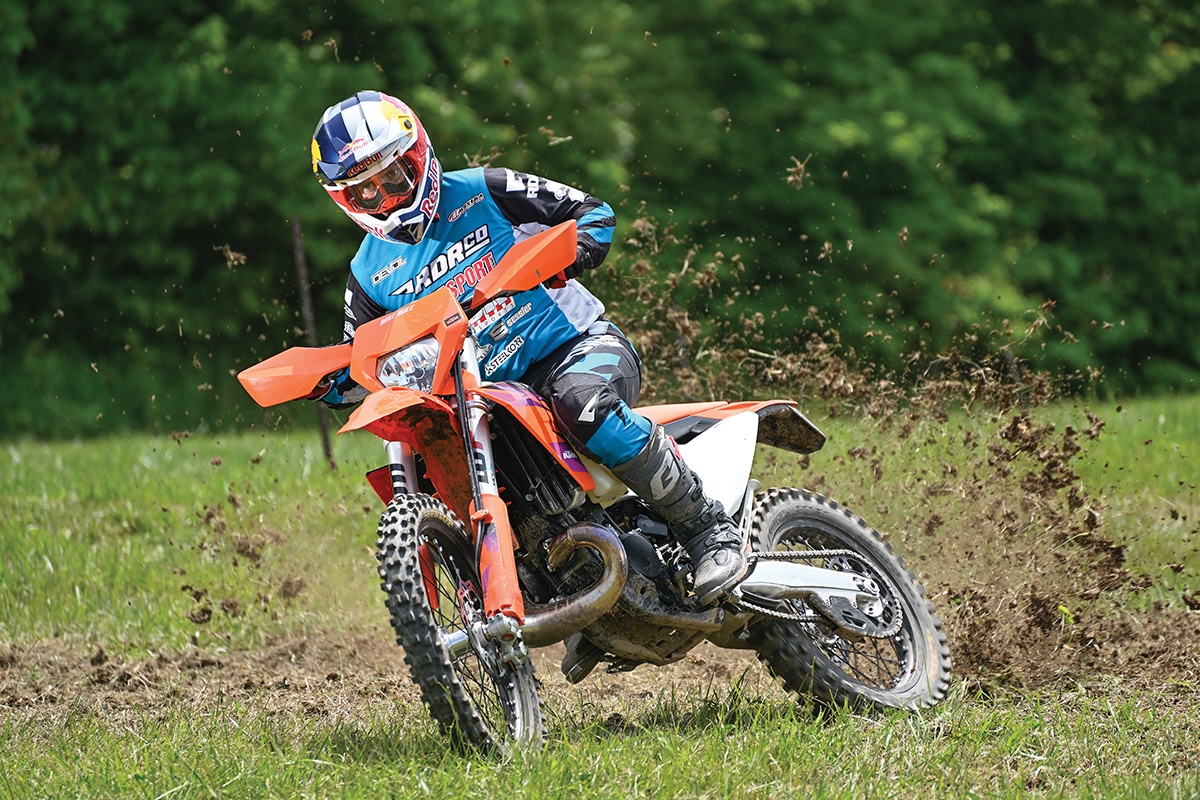With the reinvention of its XC-W off-road line, KTM’s two-year top-to-bottom transformation is complete. Model for model, the company’s motorcycles look nothing like they did two years ago. For the 2024 KTM 300XC-W, that means it got a new motor, a new frame and new suspension, just like the motocross bikes did one year ago. But, this isn’t just a repackaging of the same parts. The 300XCW is a different bike with a completely different purpose.
KTM has a confusing soup of alphanumeric names for all its bikes, but just so we’re straight on which is which, the 300XC-W is the more trail-oriented off-road 300 two-stroke, not to be confused with the SX or the XC, which are all-out race bikes. Those two bikes share most major parts, so it made sense to update them at the same time. Now, KTM has turned its attention to the W’s, which is a more challenging application of this new technology. Traditionally, the W’s are more about power quality than quantity, and in keeping with KTM tradition, they are built around the PDS no-link rear suspension.

Accordingly, the frame was redesigned from scratch with PDS in mind. It wasn’t like they could just take last year’s SX suspension and just remove the linkage. It doesn’t work like that. This shock is similar to the one on the SX, but it has a different body and radically different internals. It now has a straight-rate spring, whereas last year’s PDS bikes all had progressive springs. It also has clickers that can be adjusted by hand, even the rebound adjuster on the bottom.
There’s bigger news up front. The open-cartridge WP Xplor fork is gone. In its place is a coil-spring version of the Xact fork that comes on the competition bikes. It has a closed cartridge, and now the two fork legs are more or less symmetrical—no more split design, with the rebound damping on one side and the compression on the other. Those legs are clamped in place by a new forged and machine-finished triple clamp, unlike anything KTM has used before. The frame is new, of course, and is more rigid laterally. KTM engineers also worked hard to isolate the rear suspension’s stress and flex from affecting the action of the fork, which, as you can imagine, is no easy task but should make the job of suspension tuning a little less complicated.

THEN THERE’S THAT MOTOR…
As for the motor, it’s a whole new game. Transfer port injection (TPI) is completely gone in the KTM line, replaced now by throttle-body injection. Most riders felt the greatest thing about TPI was that it forced the adaptation of oil injection on the XC-W models. KTM kept that, so you still have the little oil filler in front of the gas cap, and you don’t have to dig out your Ratio Rite. TPI originally came in 2018 as a means to have street-homologated two-strokes in some parts of Europe. Now, KTM has attained similar results with throttle body injection, which, as it turns out, offers significant advantages for peak horsepower. TPI was smooth and great for trail riding, but the new system definitely has more bark.
Along with the injection system comes an electronic power valve, which opens up a whole new world for tuning. So far, we have just scratched the surface as far as mapping possibilities with different combinations of fuel delivery, spark advance and port timing. The 300XC-W doesn’t come with a map switch, but there are two different maps pre-programmed into the ECU. Trust us, you should buy a map switch when you get the bike.
Other updates include new bodywork and an LED headlight—at last. To help us out with the testing, we brought along Carson Brown, who is one of the most well-known two-stroke fanatics in the sport and one of very few riders who has scored national motocross points on a two-stroke. We turned him and the 300XC loose on the Russell ranch; it was fun to watch.

RENDEZVOUS AT THE JOHN PENTON
KTM invited us to ride all the new XC-Ws the day after the John Penton GNCC at Sunday Creek Raceway. We brought Carson Brown along as our primary test rider because, well, he’s Carson Brown. After a day riding in the Ohio woods and on a grass track, Carson came back completely stoked on the 300XC-W. It’s clear that KTM now sees the bike as more competition-oriented than ever before. First on the list: it’s powerful, but it doesn’t hit uncontrollably down low. It’s actually kind of mellow at low rpm, even in the more aggressive green map. In the middle it’s far, far stronger than the previous version, and it revs out much further.

Last year’s 300XC cross-country bike is a more valid comparison. That bike was so closely related to the motocross version that it was a difficult bike to use off-road. In the green map, it was so aggressive and so abrupt that very few riders could make it work properly in technical terrain. The white map was a big step down. It needed something in between. That’s where the XC-W power delivery fits. The green map is excellent for aggressive trail riding and racing, and you don’t have to be Carson Brown to hold on. The white map for the XC-W is clearly the trail riding option and might be appropriate for nightmarish Ohio mud. We missed that by a few days.
MOTO FACTOR
As far as overall handling goes, this bike is much racier feeling than it has been in the past. The frame is more rigid, the suspension is stiffer and it feels more like a race bike. The actual frame geometry isn’t that different; it’s all about flex characteristics, suspension and ergonomics. Even the PDS rear end is stiffer and stays up in its travel a little higher. In the past, there was a big divide between PDS fans and linkage devotees. Those walls are going to crumble. Even at speed, there’s no real drawback to the PDS system, and you still get advantages in ground clearance and weight.

The new fork will be a very big deal. It’s completely different from the outgoing Xplor fork. That was the most limited aspect of the previous XC-W. It worked well at low speeds, and that was it. Suspension tuners who tried to stiffen it up for racing found it a challenging task. This fork is more akin to the Xact air fork with the WP drop-in spring kit. It’s more involved than that, but in performance, that’s what it feels like. If you dropped the air pressure on your Xact suspension down into the 140-pound range, you would be close, but the new fork doesn’t have the defining characteristics of air. It’s much more stable through the deceleration and acceleration phases of any given turn and seems to have less stiction.
In the big picture, there’s going to be more overlap between this bike and the 300XC than ever. The W will still be the bike of choice for trail riders, but we will see more and more racers venturing into W-land. It has the power and suspension to be competitive in a GNCC or a hare scrambles right out of the box. Our encounter with the bike was brief, but we have a 300XC-W coming for long-term evaluation. Stay tuned.



Comments are closed.